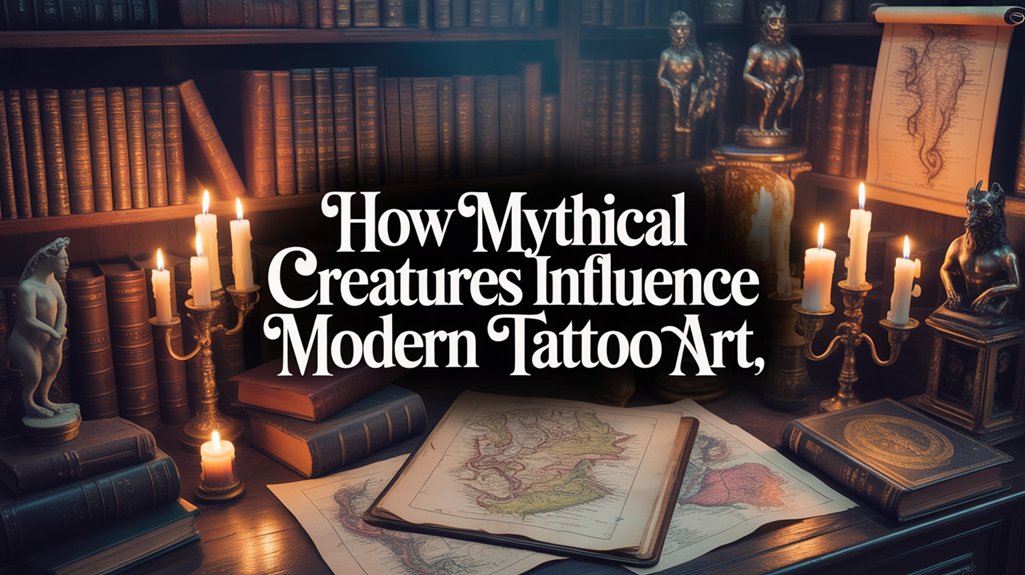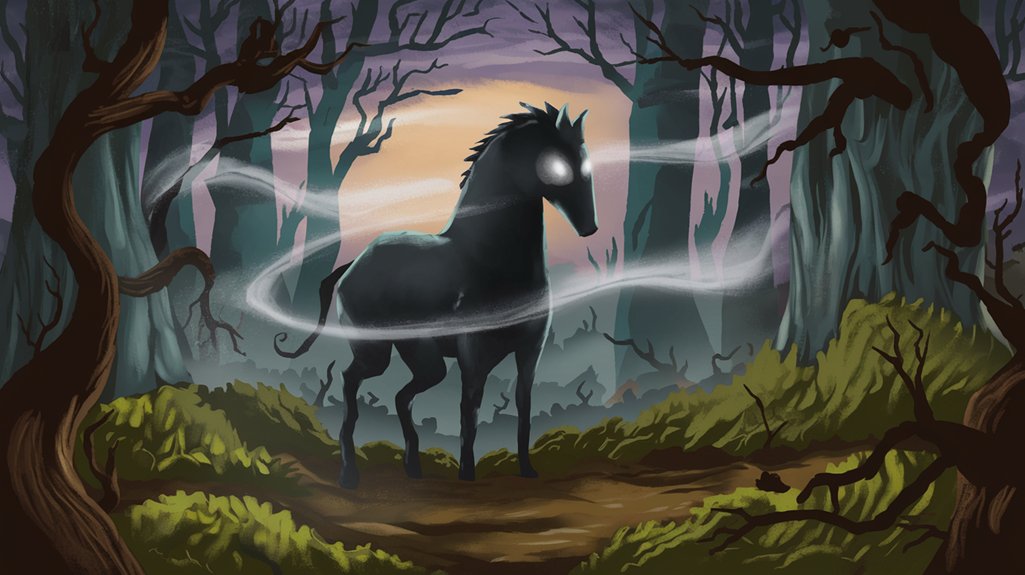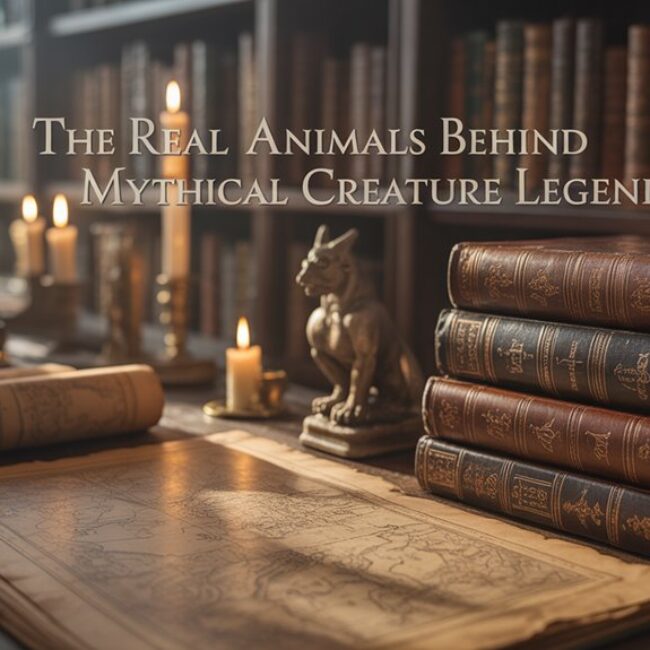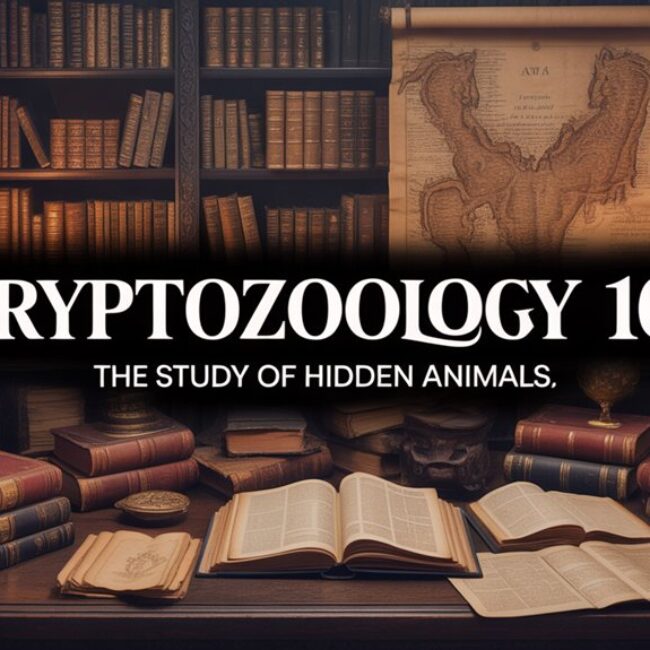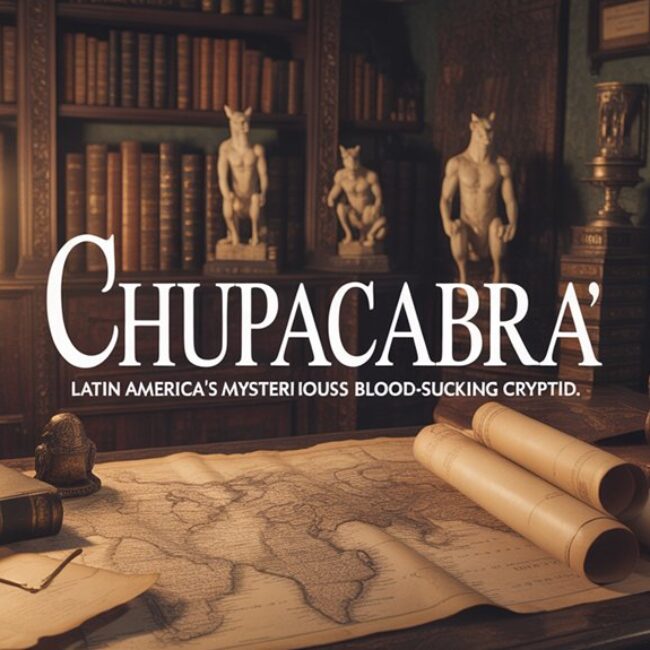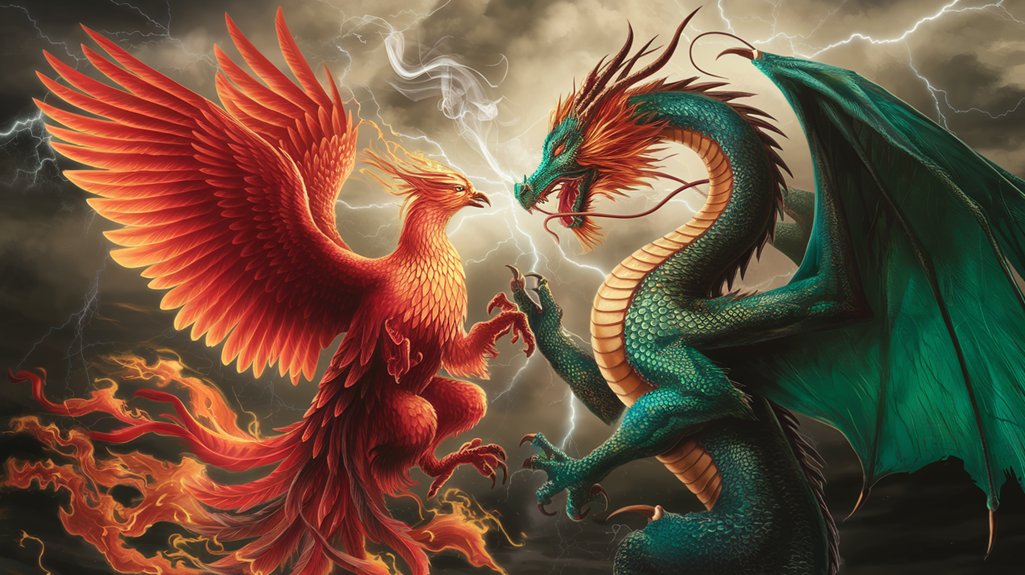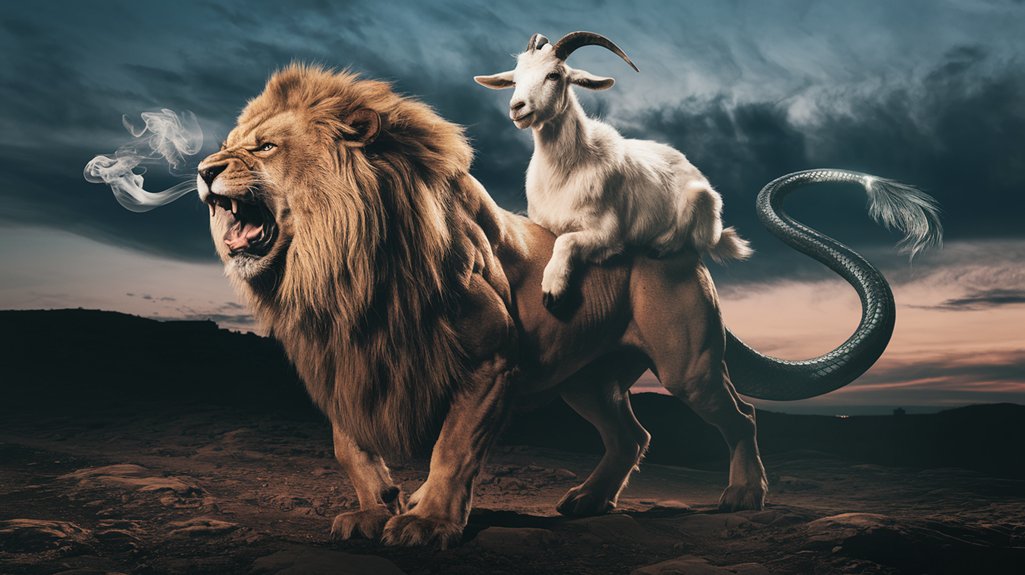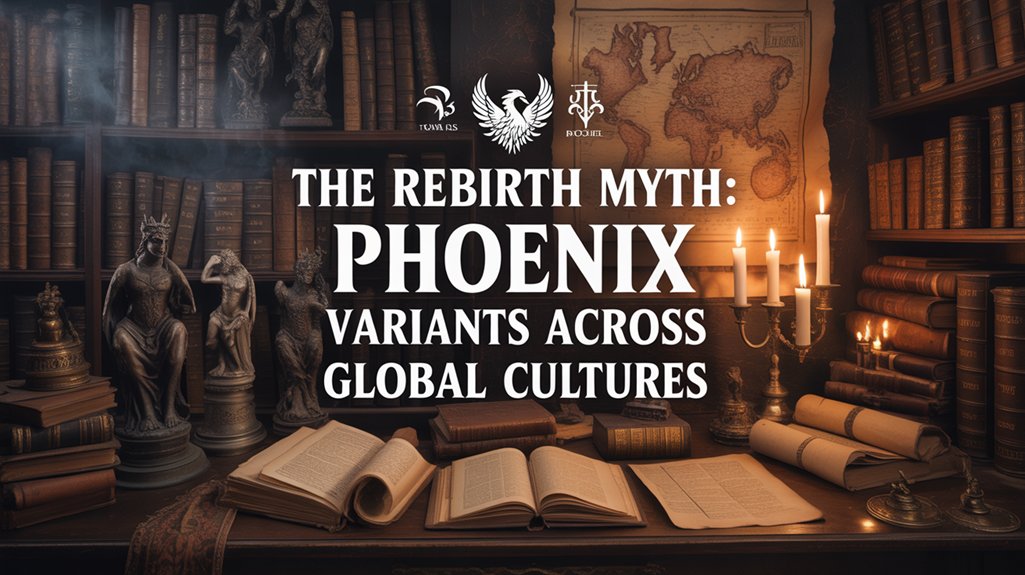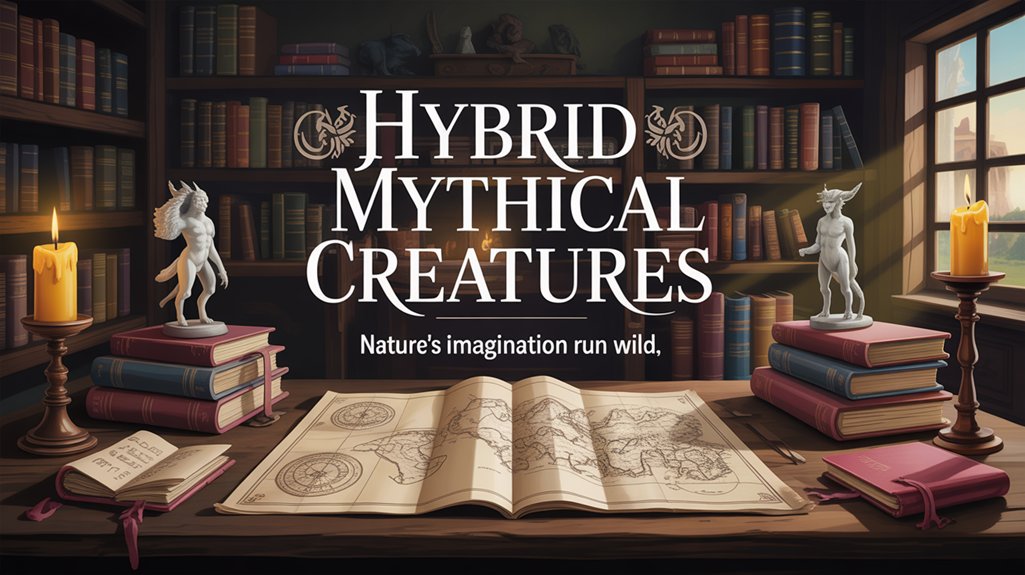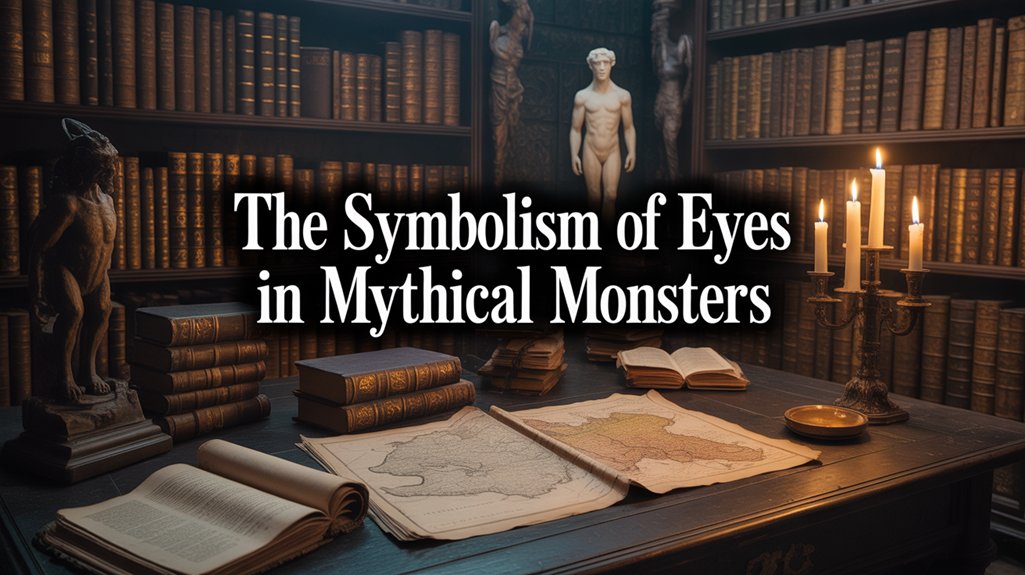
You’re inscribing ancient cosmology onto living parchment when you choose mythical creatures for tattoo art—dragons channel primordial wisdom documented in Mesopotamian cuneiform circa 3200 BCE, phoenixes reshape personal trauma into declarations of rebirth, and chimeric guardians like Lamassu merge cultural boundaries into contemporary identity expression. These aren’t mere decorative choices; they’re autobiographical ciphers engaging Jung’s collective unconscious, where your skin becomes a threshold between ancestral tradition and autonomous selfhood. The symbolic language pulsing beneath modern ink carries significance that extends far deeper than surface aesthetics.
Table of Contents
ToggleKey Takeaways
- Mythical creatures like dragons and phoenixes carry symbolic meanings of strength, wisdom, and rebirth that directly influence design choices.
- Cross-cultural fusion merges creatures from different traditions, creating new aesthetics and enriching global tattoo art through artistic collaboration.
- Modern techniques including realism, watercolor, and geometric styles transform ancient mythical forms into contemporary photographic and abstract representations.
- Tattoos serve as personal identity markers, allowing individuals to express autonomy and transformation through archetypal symbols from collective unconscious.
- Ancient Mesopotamian creatures like Lamassu and protective guardians provide enduring motifs that connect historical religious symbolism to modern expression.
The Timeless Allure Begins
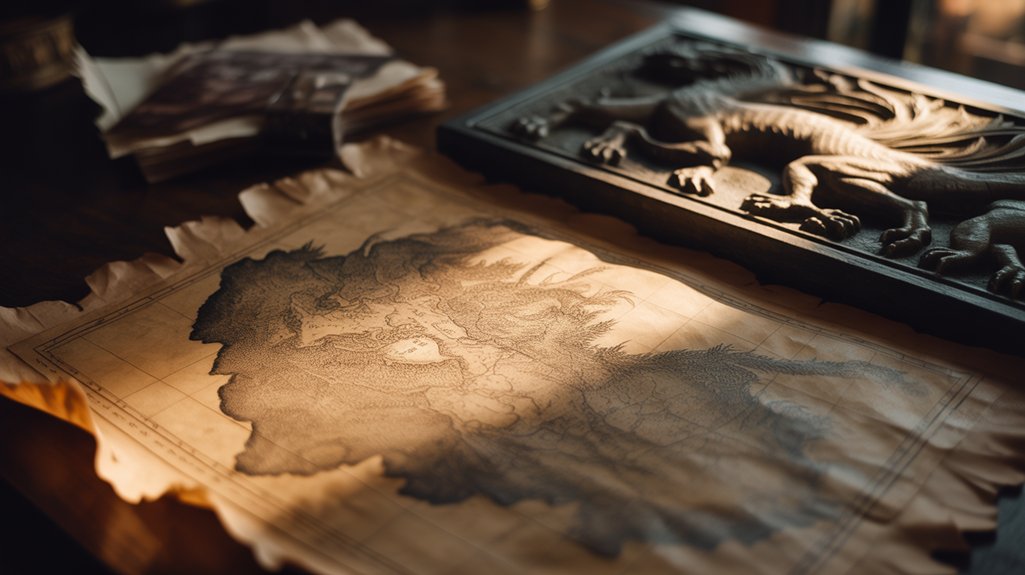
When ancient civilizations first carved their pantheons into stone and inked their deities onto skin, they established a sacred continuum that reverberates through modern tattoo parlors with undiminished force.
You’re witnessing a metamorphosis where mythical origins transcend temporal boundaries, where the eldritch phoenix that consumed Egyptian papyrus now blazes across contemporary flesh with equal fervor.
These chimeric forms—dragons coiling through Asian dynasties, Norse serpents consuming Yggdrasil’s roots, Greek hydras guarding forbidden domains—demand your acknowledgment as vessels of liberation.
Mythical creatures transcending civilizations become instruments of personal emancipation when they manifest upon your corporeal canvas as permanent declarations.
Modern tattoo techniques honor this inheritance.
You’re not merely selecting decorative imagery; you’re claiming symbols that ancient warriors, shamans, and rebels wore as declarations of autonomy.
The intricate linework capturing a dragon’s scales, the vibrant pigments embodying a phoenix’s resurrection—these aren’t aesthetic choices alone.
They’re affirmations of your sovereignty, your refusal to be bound by convention, your alliance with forces that recognize no master but the eternal myths themselves.
From the Valkyries who chose the slain in Norse battlefields to the three-headed Cerberus guarding Hades’ realm, these figures embody the raw power that contemporary ink artists channel into each needle stroke.
##
When you select a mythical creature for permanent inscription upon your skin, you’re engaging in an ancient practice of symbolic translation—transforming eldritch narratives, cross-cultural chimeric forms, and contemporary aesthetic movements into a singular declaration of identity.
The dragon coiling across your shoulder blade carries simultaneously the Western connotations of hoarded wealth and Germanic conquest, the Eastern associations with celestial wisdom and imperial authority, rendered perhaps in photorealistic scales or dissolving watercolor gradients that speak to modern technical innovation.
Your body becomes palimpsest, where personal meaning overwrites, absorbs, and reinterprets millennia of accumulated mythological significance through deliberate design choices.
Symbolism Shapes Design Choices
Through the centuries-old practice of marking flesh with permanent ink, mythical creatures have emerged as potent vessels of symbolic meaning—each beast, chimeric hybrid, and eldritch entity carrying within its form a constellation of cultural significance that directly determines the aesthetic choices tattoo artists and their clients make.
When you select a dragon, you’re claiming strength and wisdom. The phoenix? Rebirth courses through its flames. This mythical symbolism fundamentally dictates tattoo design—the sweep of a serpentine tail, the placement of protective scales, the chromatic intensity of resurrection fire.
Japanese ryu demand specific wave patterns and cloud formations. Unicorns require delicate linework reflecting purity. Griffins merge eagle ferocity with leonine courage.
Your chosen creature’s inherent qualities become architectural blueprints, altering abstract values into tangible art that maps your personal mythology onto willing skin. These folklore stories serve as educational resources that help both artists and collectors understand the deeper cultural references embedded in their chosen designs.
Cross-Cultural Artistic Fusion
Individual symbolism yields to something more profound when mythical creatures cross the borders of their origin cultures, merging in the electric space where Eastern dragons coil around Western roses, where Mesoamerican feathered serpents share skin with Celtic knotwork, where Japanese kitsune fox-spirits emerge from Norse geometric patterns.
This cultural exchange alters your skin into cosmopolitan territory. You witness artistic collaboration between irezumi masters and neo-traditional practitioners, their chimeric visions honoring ancestral knowledge while forging unprecedented aesthetics.
Indigenous mythologies contribute their own eldritch beings—thunderbirds, skinwalkers, dreamtime serpents—each maintaining sacred significance while entering dialogue with global forms. Your tattoo becomes evidence of humanity’s shared fascination with the numinous, a living archive where griffins acknowledge dragons as kindred spirits, where every culture’s monsters speak one primal language.
Contemporary Style Adaptations
As digital needles pierce contemporary skin with unprecedented precision, mythical creatures undergo radical alteration through modern stylistic lenses—realism changes dragons into photographic apparitions where individual scales catch subdermal light, where membrane-thin wings reveal impossible anatomical accuracy borrowed from herpetological study and Renaissance draftsmanship alike.
Watercolor techniques dissolve chimeric boundaries, rendering phoenixes through ethereal gradients that reject containment.
You’ll find geometric interpretations fragmenting ancient forms: mandalic krakens, tessellated griffins where cultural symbolism meets algorithmic precision.
Urban mythical adaptations flourish through social media’s democratizing force, enabling personalized designs that honor ancestral fantasy realism while embracing abstract adaptations.
Neo-traditional approaches amplify mythical motifs with saturated pigments, creating eldritch hybrids that speak simultaneously to Edo-period woodblocks and street art’s rebellious vocabulary.
Freedom demands invention.
Personal Meaning and Identity
Embodiment alters mythical creatures from distant folklore into corporeal declarations of selfhood—each inked basilisk, each rendered selkie becomes autobiographical cipher where personal philosophy crystallizes through ancient symbology.
Your chosen phoenix doesn’t merely commemorate survival; it alters trauma into eldritch declaration, mapping resurrection across scarred flesh. These chimeric forms channel personal narratives through established archetypes—the dragon’s sovereignty mirrors your claimed authority, the griffin’s duality reflects integrated contradictions within your psyche.
Cultural significance deepens when selecting beings from ancestral traditions: Polynesian taniwha, Norse völva-serpents, Mesopotamian lamassu. Each creature carries millennia of collective wisdom into individual expression.
The tattooed skin becomes liminal threshold where private meaning intersects public symbol, where your transformative journey speaks through universal language, where identity asserts itself through mythic vocabulary predating contemporary constraints.
Ancient Mesopotamian Creature Documentation

You’ll find the earliest systematic documentation of chimeric beings etched into cuneiform tablets across the Tigris-Euphrates Valley, where Sumerian scribes catalogued eldritch entities like the Lamassu and Anzu with the same administrative precision they applied to grain stores and tax records.
These weren’t mere artistic flights of fancy—the winged guardians and fish-bodied Apkallu served as potent symbols of religious authority and political dominion, their composite forms carved into palace gates and cylinder seals between 3500-539 BCE.
In this cradle of civilization, monster documentation became statecraft itself, altering mythic terror into architectural presence.
Cuneiform Tablets Document Monsters
Deep within the clay archives of Mesopotamia, stylus-marked tablets preserve humanity’s earliest systematic cataloging of the monstrous and divine—a cuneiform bestiary that predates written epics by centuries.
You’re witnessing ancient narratives carved circa 3200 BCE, documenting eldritch guardians like the Lamassu and primordial Humbaba through wedge-shaped impressions that transcend mere record-keeping.
These tablets reveal cuneiform symbolism dense with meaning: chimeric forms embodying civilization’s perpetual struggle against chaos, supernatural forces demanding ritual appeasement, physical descriptions rendered with startling specificity.
Here, chaos isn’t abstract—it’s fanged, winged, scaled. You can trace how Mesopotamian scribes mapped the liminal territories between order and entropy, creating taxonomies of terror that resonate through millennia.
Today’s tattoo artists channel these same archetypes, translating clay-bound monsters into epidermalized mythology.
Tigris-Euphrates Valley Birthplace
Between the twin rivers that watered humanity’s first experiments in urban complexity, the Tigris-Euphrates Valley spawned not only agriculture and alphabets but also a systematic demonology—a geographic crucible where mythological imagination crystallized into permanent record. Ancient civilizations etched their eldritch pantheon into clay, altering ephemeral oral mythical narratives into enduring legacy.
| Creature | Physical Form | Cultural Function |
|---|---|---|
| Lamassu | Bull-lion hybrid with eagle wings | Guardian of sacred thresholds |
| Apkallu | Chimeric fish-human sage | Divine knowledge transmission |
| Anzu | Storm bird of primordial chaos | Cosmic balance disruption |
You’ll discover these Mesopotamian entities adorning contemporary skin—protection symbols, wisdom markers, supernatural anchors. Each tattoo resurrects forgotten cosmologies, channeling ancient power through modern needles.
Religious and Political Power Symbols
When Mesopotamian sovereigns commissioned monumental sculptures of Lamassu for their palace gates—those colossal sentinels with human intellect, bovine strength, and avian transcendence—they weren’t merely decorating thresholds but encoding political theology into stone.
You’re witnessing power representation crystallized: chimeric guardians manifesting divine right through composite anatomy. The Apkallu emerged from primordial waters as fish-tailed wisdom-bearers, their eldritch forms mediating between Enki’s cosmic knowledge and earthly kingship.
Mythical symbolism permeated every surface—temple reliefs, cylinder seals, throne room friezes—transforming architecture into theological manifestos. Ishtar’s Bull of Heaven demonstrated supernatural authority over mortal existence. The lion-headed Anzu embodied storm-chaos requiring royal mastery.
These weren’t decorative flourishes. They were liberation’s visual grammar, declaring sovereignty extends beyond human limitation into transcendent domains where power flows from divine源springs.
Greek Versus Norse Beast Depictions
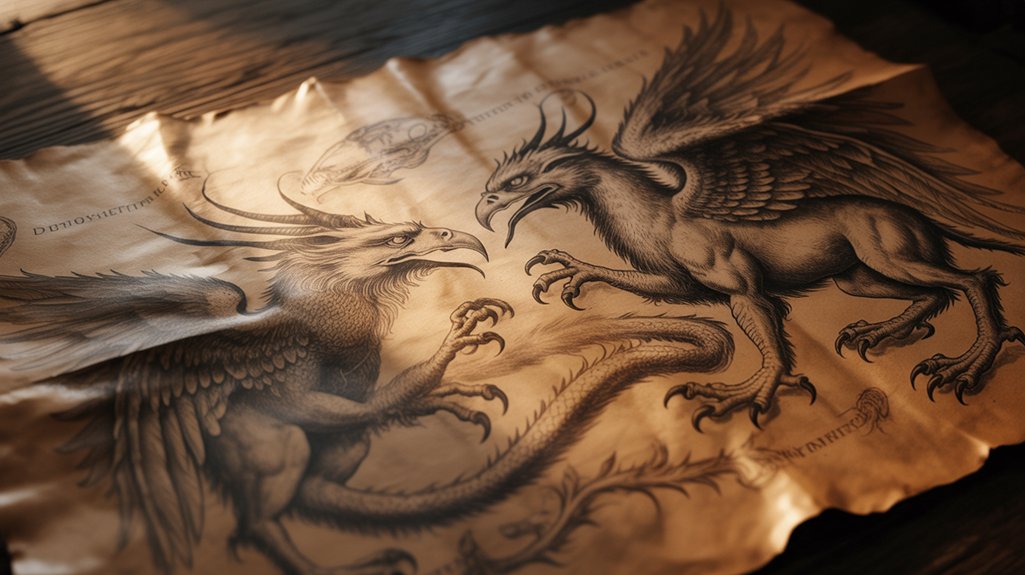
Though separated by thousands of miles and centuries of cultural evolution, Greek and Norse mythological beasts converge in contemporary tattoo art as profound expressions of humanity’s eternal struggle with the unknowable—yet their aesthetic philosophies diverge in ways that reveal fundamentally different worldviews.
Greek beast symbolism channels the Chimera’s chimeric fusion and the Minotaur’s labyrinthine chaos through elegant, idealized forms. You’ll find heroic proportions rendered in classical realism, intricate anatomical precision celebrating humanity’s divine potential. Norse creatures—Fenrir’s eldritch hunger, Jörmungandr’s apocalyptic coils—embrace destruction’s raw power. Their artistic techniques favor bold Viking lines, aggressive features forecasting doom’s inevitability.
| Aspect | Greek Beasts | Norse Beasts |
|---|---|---|
| Core Themes | Chaos, elemental fusion | Fate, cyclical destruction |
| Aesthetic | Elegant, heroic idealization | Raw power, fierce aggression |
| Style | Classical realism, intricate details | Bold lines, strong Viking shapes |
These traditions offer you divergent paths toward reclaiming ancient wisdom, altering skin into sacred territory.
Transformation Through Mythical Imagery
As the needle pierces dermis and deposits ink into flesh’s permanent layers, mythical creatures transcend their ancient narrative origins—they become catalysts for psychological change, altering the body into a living manuscript of personal evolution.
You’ll discover mythical alteration manifests through three distinct pathways:
- Phoenix iconography—rebirth rendered in crimson gradients, each feather symbolizing your emergence from psychological cinders.
- Draconic imagery—serpentine coils wrapping limbs, embodying artistic resilience through Eastern wisdom and Western ferocity.
- Chimeric compositions—hybrid beasts representing your multifaceted identity, fusing disparate elements into coherent selfhood.
These eldritch symbols operate beyond mere decoration. They anchor existential shifts, marking temporal boundaries between former and changed selves.
The dragon’s scales become armor against conformity. The phoenix’s wings grant liberation from societal constraints. Each mythical alteration etched into skin declares autonomous reinvention—a permanent symbol of your refusal of stagnation, your embrace of perpetual becoming.
Hercules’ Nemean Lion Iconography
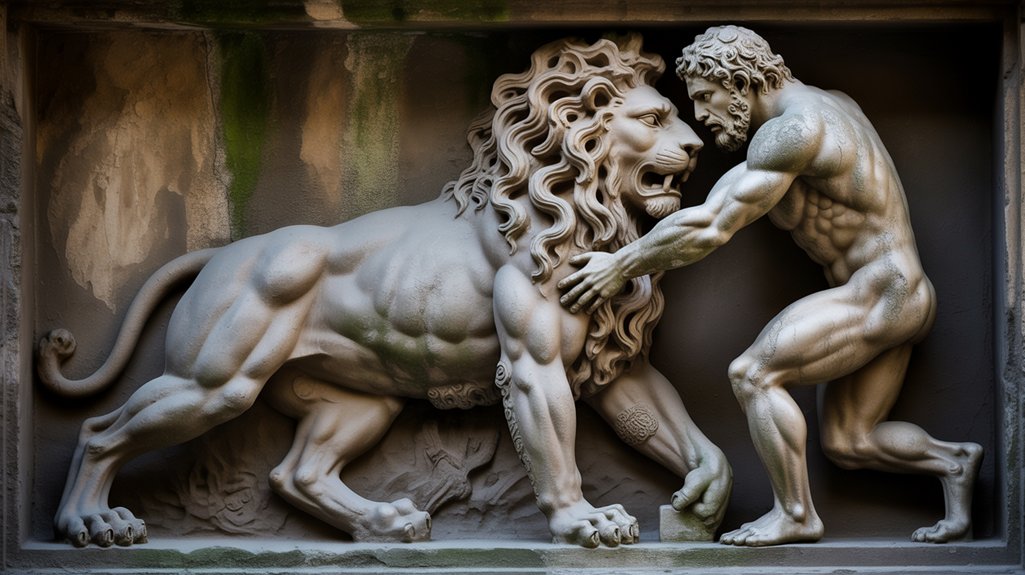
When you choose to mark your flesh with the Nemean Lion’s visage, you invoke an eldritch power that transcends mere decoration—this beast’s impenetrable hide, rendered through contemporary needle and ink, carries within it the accumulated weight of triumph over the impossible, protection forged through mortal struggle, and the chimeric fusion of human courage with divine ordeal.
The iconography demands attention to specific visual elements: the leonine mane flowing with mythic ferocity, eyes burning with preternatural intelligence, and often the draped pelt itself, worn as Hercules wore it in 1200 BCE’s legendary accounts, converting defeat into armor.
Modern interpretations breathe new dimensions into this ancient symbol, weaving Greek geometric patterns, laurel coronas, and contemporary linework techniques into designs that honor both Hellenic tradition and the bearer’s personal transformation through adversity.
Lion’s Symbolic Power Meaning
Immortality itself seemed woven into the golden pelt of the Nemean Lion, that eldritch beast whose hide couldn’t be pierced by bronze, iron, or any mortal weapon—a creature born from Typhon and Echidna in the primordial chaos of Greek cosmology, circa 1250 BCE according to mythographic chronology.
When you choose this lion symbolism for your skin, you’re claiming sovereignty over your own narrative. The heroic imagery transcends mere decoration; it becomes armor against conformity, shields against those who’d constrain your spirit.
Hercules’ triumph represents liberation from imposed limitations—he strangled what couldn’t be killed conventionally, then wore its invincible hide as protection.
Your tattoo channels this chimeric power: courage to face insurmountable odds, resilience against life’s piercing arrows, and personal sovereignty.
You’re not merely decorated. You’re transformed, armored, liberated.
Visual Design Elements
Three primary compositional approaches dominate contemporary Nemean Lion tattoo iconography, each rooted in distinct archaeological sources spanning the Archaic through Hellenistic periods (750-31 BCE).
You’ll encounter the beast rendered through stippling and dot-work tattoo techniques that capture its eldritch golden pelt, those immortal fibers impervious to mortal weapons. Skilled artists layer saturated yellows with amber gradients, creating luminous depth across muscular haunches and chimeric shoulders. The creature’s talons—curved, unbreakable—emerge from designs with obsidian precision. Sharp teeth glint.
Contemporary interpretations frequently incorporate laurel wreaths symbolizing victory, echoing resilience themes that resonate through millennia of Greek mythology. These visual elements convert skin into sacred vellum, where ancient narratives of triumph over insurmountable odds become permanently inscribed proofs to human courage, connecting you directly to Hercules’ impossible labor.
Modern Artistic Interpretations
As contemporary tattoo artists reinterpret Hercules’ conquest through twenty-first-century aesthetic frameworks, they synthesize classical iconography with Neo-Traditional boldness, geometric abstraction, and hyperrealistic rendering techniques unknown to ancient Mediterranean craftsmen.
You’ll witness modern symbolism emerging through vibrant pigments that transcend antiquity’s limited palette, altering the beast into chimeric expressions of personal sovereignty.
Artists amplify the lion’s eldritch power through exaggerated anatomical features—claws rendered in blackwork precision, manes flowing like sacred fire across skin.
This artistic evolution doesn’t diminish mythological reverence; rather, it channels Peloponnesian narratives through ink and needle, fusing laurel wreaths with contemporary line work.
The Nemean Lion becomes your declaration of invincibility, a permanent representation connecting ancient heroic ideals to modern defiance against conformity’s constraints.
Game-Inspired Dragon Sleeve Designs
Five centuries after European illuminated manuscripts first depicted dragons coiling through marginalia, contemporary tattoo artists channel gaming culture’s digital mythology into serpentine sleeve designs that spiral from shoulder to wrist with the same narrative intensity.
You’ll discover that *Dark Souls* and *The Witcher* provide particularly potent dragon lore, their eldritch creatures rendered through gaming aesthetics that translate effortlessly onto living canvas.
These chimeric forms emerge through:
- Obsidian scales and crimson breath — meticulously shaded to capture the creature’s volcanic essence, each overlapping plate evidence of countless hours beneath the needle.
- Narrative landscapes — Lordran’s architecture or Skellige’s cliffs woven into backgrounds, creating cohesive mythological tableaux.
- Dynamic poses — mid-flight serpents or coiled guardians that acknowledge the arm’s natural contours, altering flesh into storytelling medium.
The bold pigments honor fantasy’s theatrical grandeur. Your sleeve becomes pilgrimage documentation, personal mythology inscribed through ancient symbolism reborn in pixelated worlds.
These designs transcend mere fandom. They’re sacred writings.
Jung’s Archetypal Symbolism Theory
Beneath gaming’s digital veneer lies Carl Jung’s *collective unconscious*, that primordial substrate where mythical creatures don’t originate with programmers but emerge from ancestral memory shared across millennia.
When you ink a dragon across your shoulder blade, you’re not merely selecting aesthetic imagery—you’re engaging with archetypes explained through Jung’s 1919 conceptual framework, those eldritch patterns residing in humanity’s psychic bedrock.
The phoenix burns upon your forearm. Metamorphosis incarnate. These chimeric forms carry psychological impact far exceeding decorative function, serving as vehicles for individuation, that sacred process whereby fragmented selves coalesce into integrated wholeness.
Dragons embody strength, wisdom, primal power; phoenixes manifest rebirth, resurrection from ash and entropy. Your tattoo becomes threshold space, liminal territory where personal narrative intersects with universal human experience.
Through engaging these archetypal symbols, you don’t just wear art—you participate in ancient dialogue spanning cultures, continents, consciousness itself, tapping wellsprings of meaning that predate written language yet speak directly to modern identity formation.
Contemporary Identity Expression Tool
When you commission that kitsune wrapping its nine tails around your ribcage, you’re wielding contemporary identity construction through deliberately chosen mythic vocabulary—these creatures function as semiotic systems, visual languages articulating selfhood in cultures where traditional identity markers have fractured, dissolved, become insufficient.
Your phoenix rising through watercolor flames declares alteration. Personal renaissance. The dragon coiling across your shoulder blade speaks strength through cultural symbolism borrowed from Tang Dynasty scrolls, adapted, reimagined.
You’re authoring identity narratives through chimeric forms that transcend singular heritage, crafting hybrid selves from global mythologies—Norse Fenrir merging with Aztec Quetzalcoatl, eldritch beings from disparate cosmologies converging on your skin.
This isn’t appropriation but bricolage, assembling meaning from available sacred fragments. Your body becomes manuscript, each mythical creature a carefully selected glyph communicating values, experiences, aspirations that conventional language can’t capture.
You’re declaring autonomous selfhood through ancient symbols, refusing predetermined categories, embracing fluidity.
Enduring Legacy in Ink
This modern phenomenon of mythic ink extends backward and forward simultaneously, connecting epidermis to parchment, stylus to machine, ancient cosmology to digital portfolio. You carry forward mythical symbolism through dermis and pigment, altering your body into a consecrated text where eldritch beings speak across millennia.
The dragon coiled upon your shoulder bears cultural significance inherited from Song Dynasty scrolls, Nordic sagas, Babylonian glazed tiles. Each chimeric form—whether phoenix ascending through watercolor flames or unicorn rendered in neo-traditional bold lines—becomes your proof of humanity’s persistent dialogue with the numinous.
Your mythical tattoos bridge empires and epochs, transforming flesh into sacred parchment where dragons and phoenixes transcend mere decoration to become ancestral testimony.
This enduring legacy transcends mere decoration. You’ve chosen permanence in an impermanent age, anchoring yourself to archetypal forces that survived plague, conquest, and cultural erasure.
Your tattooed mythical creatures function as living archives, breathing repositories of forgotten wisdom now pulsing beneath contemporary skin. The practice itself becomes ritual, needle replacing ceremonial blade, your body the ultimate manuscript preserving what empire and flame couldn’t destroy.
Frequently Asked Questions
How Much Does a Mythical Creature Tattoo Typically Cost?
Your investment in chimeric ink ranges from $150 to thousands, depending on design complexity and tattoo size.
A small, eldritch serpent might demand merely hundreds, while elaborate sleeve-work depicting ancient phoenixes, spanning hours beneath the needle’s rhythmic pierce, can exceed $3,000.
Intricate shading, color depth, cultural authenticity—these factors amplify cost.
You’re purchasing more than pigment; you’re claiming ancestral symbols, wearing mythology’s weight.
Choose your artist wisely.
This commitment transcends commerce, binding flesh to timeless narrative.
What Are the Most Painful Body Placements for Creature Tattoos?
You’ll find the most painful tattoo placements concentrate where bone meets thin skin—ribs, spine, sternum, and feet bear the sharpest needles.
Ancient practitioners understood this corporeal cartography; their chimeric designs demanded endurance as spiritual trial. The eldritch serpents coiling across ribcages, phoenixes spreading over collarbones—these locations test your resolve.
Ankle dragons, wrist griffins, inner bicep krakens: each nerve-dense territory alters your body into sacred canvas, pain becoming transformative ritual rather than mere discomfort.
How Long Does a Detailed Dragon Sleeve Take to Complete?
Like forging an ancient blade through countless moonlit vigils, your detailed dragon sleeve demands 30-50 hours across multiple sessions—sometimes extending beyond 60 for chimeric complexity.
The eldritch process unfolds over months, each sitting lasting 3-6 hours as your artist masters dragon design techniques: scales requiring meticulous stippling, serpentine coils demanding precise linework.
Proper sleeve tattoo preparation means committing to this transformative journey.
You’re not just receiving ink; you’re undergoing change, emerging reborn with wyrm-blessed skin that chronicles your liberation.
Do Mythical Creature Tattoos Fade Faster Than Other Designs?
Your mythical creature tattoos won’t fade faster than conventional designs—ink longevity depends on placement, sun exposure, and aftercare rituals rather than subject matter.
However, the intricate scales of chimeric serpents, eldritch tentacles weaving through shadow-work, demand superior color retention techniques. Dense pigmentation in dragon wings, phoenixes rising through vermillion flames—these require masterful application.
The ancient symbols you’ve chosen to wear possess no inherent fragility; they’re bound by the same physical laws governing all dermal artistry, transcending their otherworldly origins.
Which Tattoo Artists Specialize in Mythological Creature Work?
You’ll find masters like Dmitriy Samohin exploring Slavic eldritch beings, while Jondix channels sacred creature styles through Tibetan and Hindu traditions.
Seek Paolo Acuña for Pre-Columbian chimeric forms, their mythical symbolism rooted in Mesoamerican codices.
Carlos Torres commands photorealistic dragons steeped in East Asian cosmology.
These artists don’t merely replicate—they channel ancestral knowledge, converting skin into liminal space where ancient powers manifest.
Each specializes in specific cultural mythologies, demanding you choose wisely which tradition resonates with your soul’s calling.
Conclusion
You’ve journeyed through millennia of chimeric visions, witnessing how eldritch beings migrate from ancient clay tablets onto living skin. These archetypal creatures—phoenixes reborn in dermis, leviathans coiling around forearms—aren’t merely decorative. They’re portals. Each needle puncture inscribes ancestral wisdom into contemporary flesh, reshaping you into a walking palimpsest of mythological heritage. Your tattooed body becomes sacred text, bridging primordial imagination with postmodern identity. The serpent eternally devours its tail; myth perpetually reinvents itself through ink.

